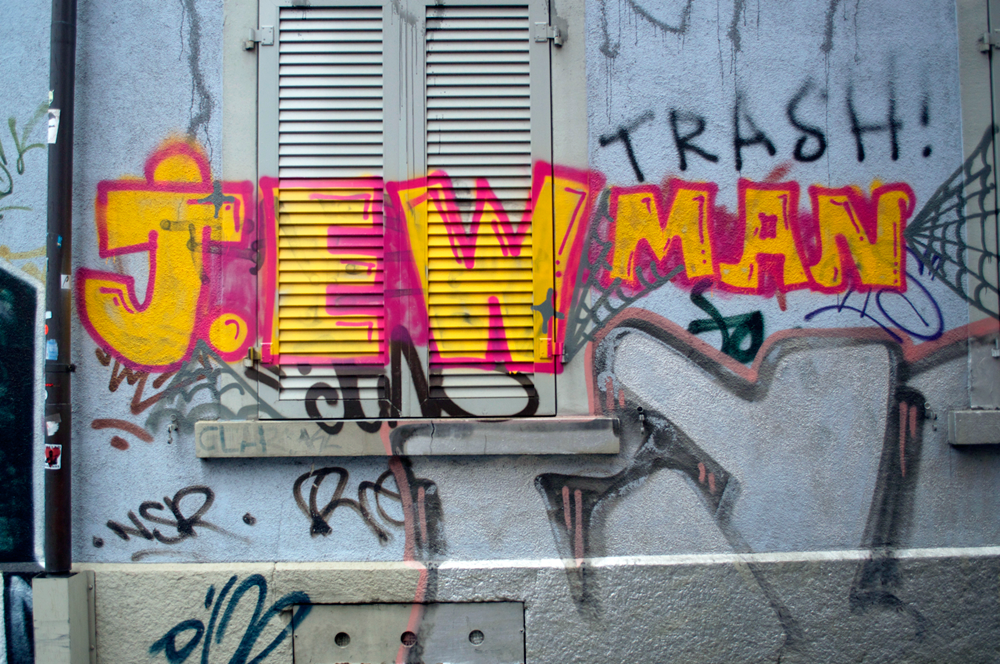Every time we drive through Zurich, the GPS fails. Nine times out of ten, the device will send my wife and I down one-way streets, or point us in the wrong direction. Having made at least half a dozen trips between Italy and Germany during the last two years, I still can’t figure whether it’s the Alps that are in the way, or that I need a new satnav system.
Fortunately, practice makes perfect. Having gone through the motions so many times, I know my way around the city well enough to get myself through it without too much difficulty. However, not so perfect that, after a day and a half’s drive from Berlin, I won’t inadvertently let myself go, hoping that the device will get it right just this one time.
Headed back to Turin after New Years, I did just that. Not only did the GPS send me the wrong way. It landed me right in front of a synagogue surrounded by political posters, and anti-Semitic graffiti. As a journalist who takes an active interest in street culture, it was a welcome mistake. Within seconds, I’d stopped the car, and was pulling out my cameras.
For anyone familiar with contemporary Swiss politics, one of the most hotly debated subjects of the last few years has been the rise of the rightwing Swiss People’s Party (SVP), and its highly controversial poster campaigns. Targeting foreigners and Muslims, their best-known effort abroad, against the building of mosques, included posters casting minarets as though they were missiles.
As controversial as this détournement was, it is by no means the only prejudicial poster pasted to walls and billboards in the mountainous European country. The SVP, and likeminded organizations, have produced many other challenging works, such as the anti-immigration billboard below, which I photographed at a rest stop last August, just before crossing the German border.
It may not be as provocative as the recasting of a house of worship into a weapon, but the sense of foreboding that it communicates, of imminent danger, is equally pronounced. “Stop mass migration.” Switzerland will be overwhelmed by invading foreigners, on the march, across the country. The military allusion of the boots is of course intentional. What we’re dealing with is an army.
This photo, taken in Lugano, in the Fall of 2010, features two different types of posters. On the left, we have an advert for a local exhibit of the work of artist Federico Pfister. Subtitled “Futurist and Intellectual Between Switzerland and Italy”, the Swiss-Italian painter was a member of the so-called “Second Futurism”, a less-politicized variant of the reactionary Italian artistic movement.
To the right is a poster featured throughout the country at the time of this picture’s taking. Displaying a photo of “Ivan S.”, an archetypal Slavic-seeming migrant, and, of course, a rapist, the poster advocates the expulsion of immigrants. “Ivan S, Rapist, soon to become Swiss.” Migrants from the Balkans (one of Switzerland’s largest immigrant communities) are criminals, is the equation.
For a country of 7,785,800, of which 1,714,000 are estimated to be of foreign origin, such explicitly discriminatory discourses ought to be deeply troubling. Twenty-two percent of Switzerland’s population (some estimates are even higher) have roots abroad. By sheer numbers alone, that ought to be enough of a guarantee against such open displays of prejudice. Unfortunately, it is not.
Hence the placing of the Jewish-themed photograph at the beginning of this article. Anti-immigrant discourses in Europe are inextricably linked to fascist anti-Semitism, and the Nazi genocide. As the most influential racist event in modern European history, this lesson is binding on all Europeans, not just Germans. Even those countries which officially remained ‘neutral’ in World War Two.
Photographs courtesy of the author







